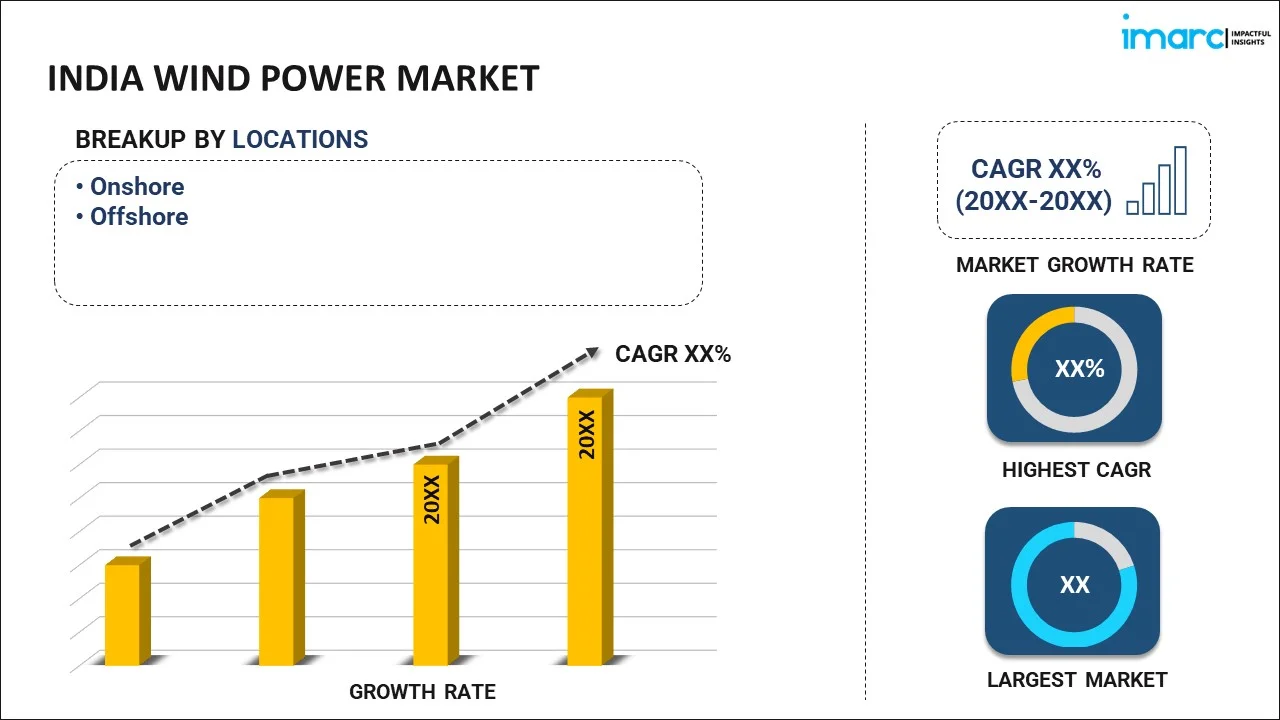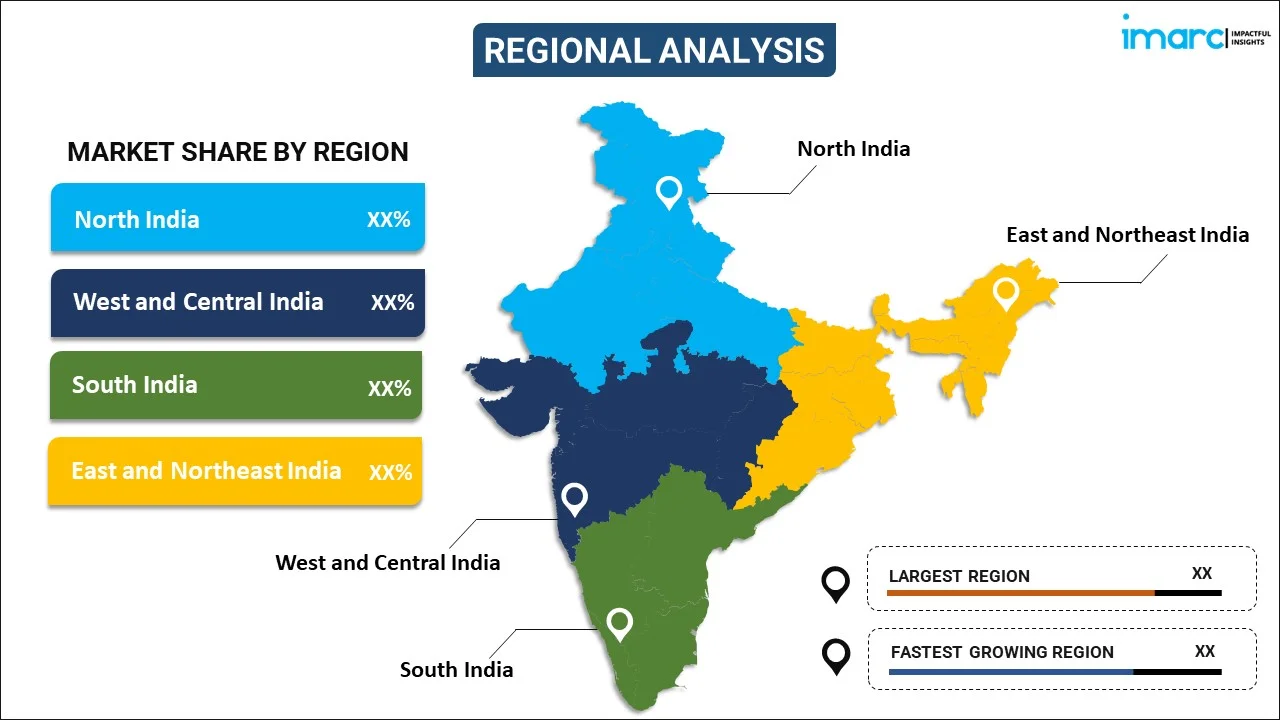
India Wind Power Market Report by Location (Onshore, Offshore), and Region 2025-2033
Market Overview:
India wind power market size reached 49.8 GW in 2024. Looking forward, IMARC Group expects the market to reach 127.9 GW by 2033, exhibiting a growth rate (CAGR) of 11.04% during 2025-2033. The escalating demand for renewable energy sources and the launch of favorable policies by government bodies, including tax subsidies, are primarily driving the market growth across the country.
|
Report Attribute
|
Key Statistics
|
|---|---|
|
Base Year
|
2024 |
|
Forecast Years
|
2025-2033 |
|
Historical Years
|
2019-2024
|
| Market Size in 2024 | 49.8 GW |
| Market Forecast in 2033 | 127.9 GW |
| Market Growth Rate (2025-2033) | 11.04% |
Wind power is a renewable energy source harnessed from the kinetic energy of the wind to generate electricity. This process involves the use of wind turbines, which consist of large blades connected to a rotor. As the wind blows, it causes the blades to rotate, converting the kinetic energy into mechanical energy. The mechanical energy is then transformed into electricity through a generator housed within the turbine. Wind power is considered an environmentally friendly and sustainable alternative to traditional fossil fuels, as it produces no greenhouse gas emissions during electricity generation. It has gained global prominence for its ability to harness a natural and abundant resource, contributing to the diversification of energy sources and the reduction of reliance on non-renewable energy. Wind power projects can range from small-scale installations to large wind farms, playing a crucial role in the transition towards cleaner and more sustainable energy systems.
India Wind Power Market Trends:
The India wind power market is undergoing significant shifts driven by key drivers and emerging trends that underscore the nation's commitment to sustainable energy. A primary driver is numerous initiatives by government bodies, such as the National Wind-Solar Hybrid Policy and the Wind Auction Scheme, that aim to boost investments and streamline project development. Moreover, technological advancements play a pivotal role, with a notable trend towards larger and more efficient wind turbines. Apart from this, the rising integration of smart technologies, data analytics, and advanced materials enhances the performance and reliability of wind power installations, making them more competitive. Furthermore, government incentives and financial support further stimulate the market, encouraging both domestic and international investments. Besides this, competitive bidding processes and feed-in tariffs contribute to the overall growth of the wind power sector across the country. Moreover, there is a growing emphasis on hybrid energy solutions, combining wind power with solar and energy storage technologies to ensure a consistent and reliable power supply. This, in turn, will continue to catalyze the India wind power market over the forecasted period.
India Wind Power Market Segmentation:
IMARC Group provides an analysis of the key trends in each segment of the market, along with forecasts at the country level for 2025-2033. Our report has categorized the market based on location.
Location Insights:

- Onshore
- Offshore
The report has provided a detailed breakup and analysis of the market based on the location. This includes onshore and offshore.
Regional Insights:

- North India
- West and Central India
- South India
- East and Northeast India
The report has also provided a comprehensive analysis of all the major regional markets, which include North India, West and Central India, South India, and East and Northeast India.
Competitive Landscape:
The market research report has also provided a comprehensive analysis of the competitive landscape in the market. Competitive analysis such as market structure, key player positioning, top winning strategies, competitive dashboard, and company evaluation quadrant has been covered in the report. Also, detailed profiles of all major companies have been provided.
India Wind Power Market Report Coverage:
| Report Features | Details |
|---|---|
| Base Year of the Analysis | 2024 |
| Historical Period | 2019-2024 |
| Forecast Period | 2025-2033 |
| Units | GW |
| Scope of the Report | Exploration of Historical Trends and Market Outlook, Industry Catalysts and Challenges, Segment-Wise Historical and Future Market Assessment:
|
| Locations Covered | Onshore, Offshore |
| Regions Covered | North India, West and Central India, South India, East and Northeast India |
| Customization Scope | 10% Free Customization |
| Post-Sale Analyst Support | 10-12 Weeks |
| Delivery Format | PDF and Excel through Email (We can also provide the editable version of the report in PPT/Word format on special request) |
Key Questions Answered in This Report:
- How has the India wind power market performed so far and how will it perform in the coming years?
- What has been the impact of COVID-19 on the India wind power market?
- What is the breakup of the India wind power market on the basis of location?
- What are the various stages in the value chain of the India wind power market?
- What are the key driving factors and challenges in the India wind power?
- What is the structure of the India wind power market and who are the key players?
- What is the degree of competition in the India wind power market?
Key Benefits for Stakeholders:
- IMARC’s industry report offers a comprehensive quantitative analysis of various market segments, historical and current market trends, market forecasts, and dynamics of the India wind power market from 2019-2033.
- The research report provides the latest information on the market drivers, challenges, and opportunities in the India wind power market.
- Porter's five forces analysis assist stakeholders in assessing the impact of new entrants, competitive rivalry, supplier power, buyer power, and the threat of substitution. It helps stakeholders to analyze the level of competition within the India wind power industry and its attractiveness.
- Competitive landscape allows stakeholders to understand their competitive environment and provides an insight into the current positions of key players in the market.
Need more help?
- Speak to our experienced analysts for insights on the current market scenarios.
- Include additional segments and countries to customize the report as per your requirement.
- Gain an unparalleled competitive advantage in your domain by understanding how to utilize the report and positively impacting your operations and revenue.
- For further assistance, please connect with our analysts.
 Inquire Before Buying
Inquire Before Buying
 Speak to an Analyst
Speak to an Analyst
 Request Brochure
Request Brochure
 Request Customization
Request Customization




.webp)




.webp)












